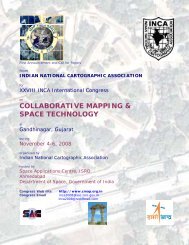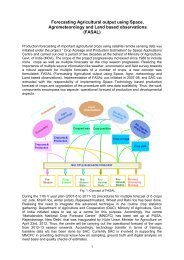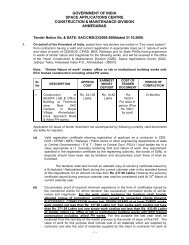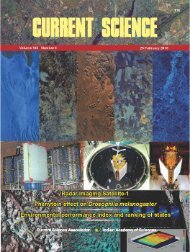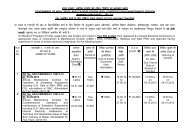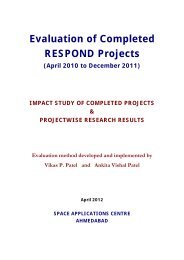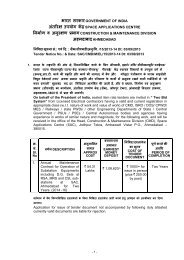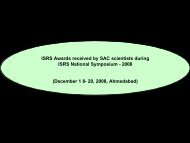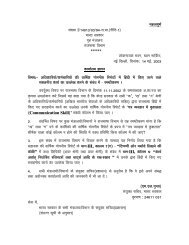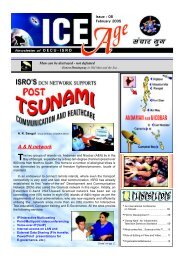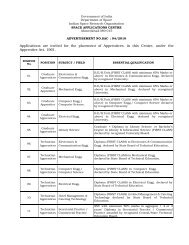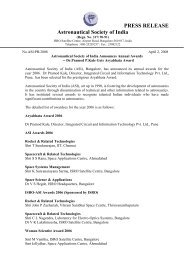Download PDF - Space Applications Centre
Download PDF - Space Applications Centre
Download PDF - Space Applications Centre
You also want an ePaper? Increase the reach of your titles
YUMPU automatically turns print PDFs into web optimized ePapers that Google loves.
IGNOU Radio Networking through<br />
EDUSAT<br />
Vilas Palsule, APD, Edusat R&D, SAC<br />
The network for distance<br />
education having two-way<br />
video has already been set<br />
up at IGNOU. With the existing<br />
network it has been planned to<br />
add Radio Broadcast. IGNOU<br />
already has "FM Transmitters" at<br />
25 independent locations spread<br />
all over India, each one covering<br />
a very limited local area. It is now<br />
proposed to inter-link all the<br />
25 locations through existing<br />
EDUSAT network for radio<br />
re-broadcast purposes. The<br />
proposed network does not<br />
require any additional infrastructure<br />
for the locations where<br />
EDUSAT terminal already exists.<br />
However, an additional EDUSAT terminal is required, in case of<br />
non availability, for bringing the FM radio local transmitter<br />
into a IGNOU Radio Broadcasting Network.<br />
Any FM local transmitter can be put on a nation wide<br />
broadcast network of IGNOU by linking it to remaining FM<br />
transmitters. This is possible since all FM transmitters are<br />
collocated with the EDUSAT Terminals. The main broadcaster<br />
FM transmitter (A predefined one out of 25 at any given time<br />
whichever it may be) is connected to the collocated EDUSAT<br />
terminal and is put on National IGNOU network by allocating an<br />
exclusive bandwidth for 128 KBPS Data rate for audio/music<br />
transmission. This EDUSAT terminal is then operated in Multicast<br />
mode. With this configuration now each and every EDUSAT<br />
terminal commissioned on IGNOU network starts receiving the<br />
audio/music transmission from the Main broadcaster. Now this<br />
received FM broadcast signal at the EDUSAT terminal at all the<br />
remaining FM locations are re-broadcast from the respective local<br />
FM transmitters. The same signal which is originated from the<br />
main broadcaster, is thus aired from all the local FM transmitter.<br />
In this configuration it is feasible to allot the status of "Main Radio<br />
Broadcaster Station" to any one FM local transmitter for<br />
pre-decided and predefined time.<br />
Experience in Implementation of<br />
EDUSAT Network<br />
Vikram Desai, DPD, Edusat Implementation, DECU<br />
The Installation & Commissioning (I & C) of various<br />
networks of EDUSAT is done thorough different service<br />
providers, under the supervision of DECU/ISRO. The agencies<br />
involved in installation and commissioning phase are as follows:<br />
In case of Pilot Project the service provider was M/s. Essel<br />
Shyam Technologies Ltd, Semi-operational phase of national beam<br />
is being served by Infinium (India) Ltd., where as the regional<br />
beam are taken care by BEL and HECL. The network for Blind<br />
People Association (BPA) was installed by M/s Accord.<br />
In semi-operational phase the job is given on a turn key basis<br />
with comprehensive AMC because of the lessons learnt from the<br />
pilot phase where different sub systems were procured<br />
for different vendors. This made it difficult to pin point<br />
responsibility.<br />
In the field several difficulties are faced like non availability<br />
of coordinator, non-readiness of site, lack of understanding of the<br />
requirements at the user level, earthling, using choice of<br />
classroom etc.<br />
Such situation creates problem for both (DECU and nodal<br />
agency) and has both schedule and financial implementation. Now<br />
steps are being taken to orient and train the custodians before the<br />
equipment is dispatched.<br />
EDUSAT Update Volume : 04, November 2005<br />
1
Haresh Bhatt,<br />
SF, Network Division, SAC<br />
EDUSAT Gateway is the entry point to access various collaborative services that are planned and will be planned to<br />
enhance the EDUSAT utilization. It will facilitate the members from different educational organizations like UGC, CEC,<br />
IGNOU, NCERT etc. to join, collaborate and work together to achieve defined goal and objectives. The services can be<br />
accessed both from EDUSAT network as well as Internet.<br />
There could be a number of collaborative services that can be enabled under the EDUSAT gateway. Presently, we have<br />
configured only three services i.e. EDUSAT Gateway itself, EDUSAT Forum and Metadata Archival of Learning Contents. All<br />
these services are web-based and can be accessed through the standard web browser. Users are presented with personalized<br />
and updated information, workflow is supported so that only the authenticated and approved information are reached to the<br />
end-user and any sort of pending action are communicated through back-end emails to the respective service provider.<br />
The features of EDUSAT Gateway like online registration and subscription, Notices, Events and Lecture Schedules announcements,<br />
Feedback & FAQ, Responsibility Management, Interface to specific services etc. are made available to all the<br />
users.<br />
EDUSAT Forum is a platform through which members from different educational institutes can collaborate in terms of<br />
workgroups. There could be a number of workgroups that can be created under this forum. Each workgroup has well defined<br />
goal & objectives, tenure, deliverables, active members, reviewers and observers. Some of the workgroups are Primary School<br />
Education workgroup, Standardization of Learning Content Metadata group, EDUSAT Operanionalisation Group etc. At<br />
forum level facilities like Newsletter and subscription, Article Archival and publishing, Archival of documents that are finalized<br />
by different workgroups, Registration to different workgroups, responsibilities management etc are accessible to all the<br />
forum users irrespective of their workgroup membership. Similar facilities are also enabled at the workgroup level but the<br />
items are confined only to the members of the respective workgroup and are not accessible to the other users. Apart from that,<br />
workgroup members can participate in the important discussion through the Discussion Thread facility and document generation<br />
process through the Document Generation facility that fully automate the workflow of document generation among the<br />
editor, co-author, reviewing committee and approver.<br />
Metadata Archival for Learning Contents facilitate the Content providers to share the information about the Learning<br />
contents. This information is very useful to students, teachers and other users to locate the right learning contents. It includes<br />
registration of content providers, content information archival, retrieval and extensive search facility. Students and teachers<br />
can set their preferences for languages, educational context and discipline, so that they only get the new updates as per their<br />
interest. To make the content information interoperable, we have adopted IEEE LOM 1484 standard to capture the learning<br />
content information.<br />
Rollout phase of operation consists of about 10 working groups concentrating on Roll out, Meta data archival and 1484<br />
customization, Standardization, EDUSAT Information and operation management, EDUSAT Utilisation, End User Interface,<br />
Outreach policy and mechanism and Satellite Technology.<br />
The gateway is already installed on EDUSAT network and its clone will be installed on Internet. Both will be isolated but<br />
will be synchronized from time to time.<br />
The features of EDUSAT Gateway like online registration and subscription, Notices, Events and<br />
Lecture Schedules announcements, Feedback & FAQ, Responsibility Management, Interface to<br />
specific services etc. are made available to all the users.<br />
2 EDUSAT Update Volume : 04, November 2005
INDO US Workshop,<br />
October 15-19, 2005<br />
VTU-EDUSAT Conference, September 16-17, 2005<br />
In order to commemorate one year of successful utilizationf VTU-EDUSAT<br />
network, ISRO and VTU jointly conducted a two-day conference from Sep<br />
tember 16, 2005 at BMS College of Engineering, Bangalore. The objective of<br />
the conference was mainly to create awareness among various stakeholders in higher<br />
education in Karnataka on VTU-EDUSAT programmes.<br />
Mr. G. Madhavan Nair, Chairman, ISRO, inaugurated the conference in the august<br />
presence of Mrs. Sobha Nambisan, Principal Secretary (Higher Education), Government<br />
of Karnataka and Dr. K. Balaveera Reddy, Vice Chancellor, VTU. The conference<br />
was attended by several delegates of VTU and ISRO.Having gained experience<br />
in utilizing the EDUSAT network for one year, VTU is poised to transmit about 470<br />
live sessions covering eight full-semester subjects, technology-specific courses, soft<br />
skill and CXO Speaks programmes from September 16, 2005.<br />
The workshop on Utilisation<br />
of <strong>Space</strong> based Resources<br />
for Enhancing Science<br />
Education in India was jointly<br />
organised by Indo-US Forum for<br />
Science and Technology (IUSSTF),<br />
New Delhi along with Homi<br />
Bhabha <strong>Centre</strong> for Science Education/Tata<br />
Institute for Fundamental<br />
Research, Mumbai at Aurangabad<br />
during October 15-19, 2005. The<br />
workshop was organised with a<br />
view to bring together the experts<br />
from the United States and India to<br />
discuss strategies for the utilisation<br />
of resources available or developed<br />
in the respective countries to<br />
enhance the science education in<br />
India. In this perspective,<br />
the EDUSAT network was<br />
demonstrated by crating the<br />
teaching end at Aurangabad and one<br />
of the receiving end at Science City,<br />
Ahmedabad.<br />
Director DECU inaugurated the<br />
Indo US workshop from Science<br />
City, Ahmedabad. On second day of<br />
the conference, students were<br />
invited to interact with the scientist<br />
present at Aurangabad. In both the<br />
days the students as well as teachers<br />
from Kendriya Vidhyalaya, SAC<br />
and different schools under Gujarat<br />
Secondary and Higher S econdary<br />
Education Board (GSHSEB)<br />
participated in three hours long<br />
interactive session on Earth, Moon<br />
and Mars. The interaction between<br />
the teaching end and the receiving<br />
end was satisfactory.<br />
EDUSAT Update Volume : 04, November 2005<br />
3
VTU<br />
Feedback on utilisation<br />
EDUSAT<br />
Dear Prof. Shesha Prakash,<br />
Iwatched your class this morning. Your pace of presentation, diction and gestures were very<br />
good. Your attempt to solve old question papers is laudable. Pl. post me the feedback of your<br />
students at Sullia in terms of effectiveness and transmission quality.<br />
Music to ears… your appreciation is well taken. It is only teachers like you can make this programme<br />
useful and interesting.<br />
Tnx again,<br />
Rgds,<br />
A student from VTU<br />
Dear Prof. Shekar<br />
Iam extremely happy to be a part of the above highly ambitious mega project, which is being<br />
executed meticulously with all effort from your side. I have been one among others who had<br />
always encouraged and emphasised on the sharing of knowledge of elite class in academics who are<br />
capable of delivering the goods with have nots. Our system is like only few will be able to get the best<br />
of every thing whereas there is a large chunk of people who are deprived of this facility. You, with<br />
VTU and ISRO have done an excellent job in bringing the best of technical education to those deprived<br />
section. I wish to congratulate you and your team for this stupendous job. Our college is one<br />
among others who are utilising this facility. In fact I being the teacher for the same subject in our<br />
college also, I had instructed to students that I will not be covering that syllabus that I am covering<br />
through VTU EDUSAT classes. I found this to be highly effective. Students are listening to me and<br />
watching me live on TV. I had included this portion in the I Test and I was happy to note that the<br />
average marks obtained is above 20 out of 25 and about 25% of them have scored 25. I wanted to share<br />
this with you. I shall keep in touch with you. If you have anything pl. be in touch with me. That is all<br />
for now,<br />
2<br />
EM RC, Ahmedabad<br />
Yours sincerely<br />
Dr. M.N. Shesha Prakash<br />
Professor of Civil Engineering and Dean (Engineering)\<br />
Jawaharlal Nehru National College of Engineering<br />
Shimoga - 577 204<br />
C<br />
2<br />
EC, New Delhi has connected all the EM RC centres through EDUSAT network. EM2RC,<br />
Ahmedabad was teaching end on October 17, 05. The programme was observed at CEC,<br />
New Delhi. We have received the feedback of the observation made at New Delhi and also of EM2RC,<br />
Ahmedabad which shares their experience in using the network.<br />
2<br />
Some of the observations of EM RC, Ahmedabad in using the network are:<br />
ISRO has selected VLC software for video streaming, which is in the process of validation. Thus it<br />
raises a question of suitability for such an expensive venture of EDUSAT.<br />
The guideline provided by ISRO clearly mentions that it is not mandatory to have more than one PC<br />
for SIT. I am of a strong belief that to run a show one needs at least two PCs for the classroom and<br />
while three set of PCs for the teaching end. When ISRO guideline does not make this requirement<br />
quite clear it becomes impossible for the person who is dealing with the day to day affair to persuade<br />
the authorities for the provision of the facility.<br />
Contd.on pg. 5<br />
4 EDUSAT Update Volume : 04, November 2005
Contd. from pg. 4<br />
<br />
<br />
Though the system appears very simple and cost effective with only one or two multimedia PCs, my experience tells me that you<br />
need soundproof AC studio and many more video production equipments for desired quality. This should be clearly put to the<br />
user agencies.<br />
I also fail to understand that as a classroom end one has to have web based equipment while for teaching end video based equip<br />
ment. The market is not yet ready in providing complete set of web based equipment. It gives clear signal that the system is yet<br />
shaping up and there are many missing links. However, all this make the system very complicated and less user friendly.<br />
Dr.(Ms.) Ila Joshi<br />
2<br />
Research Officer, EM RC<br />
The programme was observed at New Delhi on October 17, 05. The audio and video quality of the programme was very good and it<br />
looked like a satellite TV channel; 11 questions were asked from 6 receiving centres; the presentation style of the subject expert was<br />
good. Besides some suggestions and recommendations for improving the method of transmission has been communicated to the user.<br />
IGNOU's experiences with EDUSAT……..<br />
Pradeep Kaul<br />
Jt. Director, CEC<br />
IGNOU started the usage of EDUSAT from Feb. 2005.<br />
In the initial period it was used for developing the channel itself. Once the Satellite interactive terminals (SIT) were installed by<br />
the vendor at EDUSAT sites, the integration of the peripheral equipment with SIT was taken up by the IGNOU staff. The strength<br />
of the EDUSAT network backed by the existing network of Gyan Darshan television network was used for imparting integration training<br />
to the staff at EDUSAT centers/nodes. Instead of sending the engineers from IGNOU headquarter to remote centers for undertaking the<br />
integration task, the training was conducted through the network. and providing on site or in situ training for concerned staff.<br />
This helped in minimizing the logistics and financial expenditure while accomplishing the task in record time. The application<br />
software required for operations was distributed to all centers through the EDUSAT network. The techniques of remote diagnostics<br />
were utilized in fault rectification on receiving a request from various centers. The concerned staff was provided training on preventive<br />
maintenance techniques through a series of teleconferences.<br />
Presently, the facility is being fully used for dissemination of curricula based programmes for ODL students, cover major events<br />
such as VVIP visits to the university, special lectures, training of various functionaries including Regional <strong>Centre</strong> Staff through net<br />
meetings and so on.<br />
The facility is being daily from 11 a.m. to 4.30 p.m. for curriculum based tele counseling. This is being done as per a fixed point<br />
chart and students are informed in advance through the Regional Services Division of IGNOU. As the downlinks are still being installed,<br />
in order to reach out to wider section of students, the programmes are being simulcast on GD-2.<br />
In addition, there has been intermittent usage for training purposes for periods up to a fortnight each from 4.30 p.m. to 5.30 p.m.<br />
This has substantially cut down the travel for many officials for conducting on site training. EDUSAT network is also being used for<br />
point-to-point communication needs between any two centers.<br />
To prepare for the forthcoming lectures on EDUSAT network by the Hon'ble President of India, the capabilities of the network are<br />
being further expanded by installing new hardware & software at all sites. Once again, as it happened during initial phase, the network<br />
is being utilized for it's own growth and maintenance by conducting the integration related mode through the network itself. And the<br />
facility is also being used by the concerned technical staff for trouble shooting and maintenance as well as for administrative meets.<br />
Ms. Usha Chandar<br />
Research Officer, IGNOU<br />
EDUSAT Update Volume : 04, November 2005<br />
5
Bhargav Thakkar, Producer, VPG-DECU<br />
"I never even dreamt that the EDUSAT can do such a unique<br />
communication system for meeting the requirements of visually<br />
challenged people. It is very highly satisfying that the high technology<br />
of the satellite and digital connectivity is being utilized<br />
for such a noble cause and as mentioned by Mr. Punani (The Exe.<br />
Director,BPA) it is perhaps first in the world and we stand to demonstrate<br />
to the other people to follow."<br />
These were the words of none other than the Chairman ISRO,<br />
Mr. Madhavan Nair. He was inaugurating the Blind People Association-<br />
EDUSAT network at Ahmedabad on 30th August<br />
2005.The idea generated by the writer of this article became the<br />
catalyst and could generate the interest and enthusiasm in the<br />
management of Blind People Association for the education of blind<br />
people through satellite.<br />
They approached Mr. B.S.Bhatia, Director, DECU with the<br />
special and unique requirement in the proposal of network to<br />
be set-up for the noble purpose. The need was to establish network<br />
configuration, which was to deliver live audio and data that<br />
could be red by blind students in Braille, through its printed impression.<br />
Mr. Bhatia took it as an interesting challenge and the<br />
blind people of Gujarat are now lucky enough to access the unique<br />
satellite network within a short time. Today Mr. Bhatia is also<br />
sure that the network will do well and it will be utilized properly.<br />
He is satisfied that it is in safe and right hands.<br />
The network functions in two distinct but independent modes<br />
i.e.(A)Data Broadcast mode and (B) Audio Broadcast mode. In<br />
data mode, the written instructions(mostly word document) from<br />
the teaching end is broadcast in User Diagram Protocol (UDP)<br />
mode where it is (Data) automatically stored in a file at each and<br />
every remote classroom. In UDP mode of broadcasting, an assurance<br />
of error free data collection at all the remote is essential<br />
since there is no return acknowledgement.<br />
This is achieved by broadcasting the data several times from teaching<br />
end while each individual classroom receives all the data but<br />
stores only totally error free and converts in to data automatically.<br />
This instructional data is then provided to every student in<br />
advance to a live audio lecture by taking "Braille" printer output.<br />
Now live audio instructions are transmitted from the teaching<br />
end in audio broadcast mode.<br />
The instructor is simultaneously heard by the entire student<br />
community already having Braille's printed data in their hands.<br />
These two together enable a blind student to practice the instruction<br />
with full efficiency. In the first phase ten centres spread over<br />
North, South, East, West of Gujarat will be covered in this network.<br />
In the second phase thirty more centres will come up." All<br />
the blind students will be able to access the best teacher and the<br />
best learning material at the same given time and also will be able<br />
to store the material on the hard disc of the computer to access it<br />
later.<br />
It is indeed the revolution in the 125 years old history of<br />
blind people's education. The year 2005 will be a landmark in our<br />
history because for the first time it happens so that the high<br />
technology came first to us to help us in the education. "These<br />
were the words of a brilliant teacher Mr.Ranchodbhai Soni at<br />
BPA,Ahmedabad.<br />
According to Mr.Jasubhai Kavi (Principal,BPA school)the<br />
reach of knowledge and first hand information will increase the<br />
pace and the width for the blind students in this age of information<br />
and technology. "You have placed them 200 years ahead<br />
with the help of satellite technology." he had to say. Mr.Nalin<br />
Patel a blind student at far end of Gujarat was more than happy<br />
receiving the information and knowledge on his computer. He<br />
could feel the touch of satellite technology.<br />
6 EDUSAT Update Volume : 04, November 2005



